Proximity switch with "Metal Face"
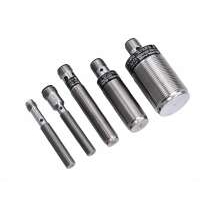
Metal face proximity sensors
Some applications place particularly high demands on the robustness of sensors. These rugged and durable "Metal Face“ sensors are enclosed in stainless steel making them the best selection for these tough applications. Applications such as machine tools or metal processing will often expose the sensor to target impact, abrasion and the affects of aggressive solvents and fluid.
In these applications, sensors with a stainless steel sensing face may reduce down time and extend service-life making your overall production more profitable.
Our "Metal Face“ product series (NMB…) is available in 2 versions, (FE) for detection of ferrous metals and (NFE) for detection of non-ferrous metals.
Inductive analog output sensors

Inductive analog output sensors
Inductive analog output sensors are used to detect metal objects within specific operating ranges. This object distance is then translated into an analog output signal proportional to distance, making these sensors ideally suited for measuring and control applications. The Pepperl+Fuchs product offering includes operational detection ranges from 2 … 5 mm, 3 ... 8 mm, and 15 ... 40 mm. Due to the low temperature deviation of our inductive analog sensor product, only 1/1000 of the final value per degree Celsius, the sensor remains reliable and accurate even under non-constant ambient conditions.
Bus-enabled proximity switches

AS-Interface proximity sensor
In multiple sensor applications, a communications network often connects sensors so that system coordination can be accomplished. We offer a line of intelligent proximity sensors that extend their functionality to include supply line monitoring, diagnostics and network communication with a programmable logic controller.
Using our AS-interface proximity sensors the user can network up to 31 (specification 2.0) or 62 (specification 2.1) proximity switches per master.
Proximity switches with AS-interface are equipped with a failure warning indication, a on/off switching delay, and an internal oscillator monitoring function. These sensors are available in cylindrical, rectangular and screw-on "F" design housing styles.
Pressure-resistant proximity switches
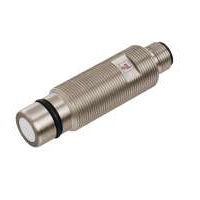
Pressure resistant proximity switch
Pressure-resistant proximity switches are suitable for use in hydraulic actuators and cylinders. The sensors are able to withstand pressures up to 350 bar (M18 cylindrical style) or 500 bar (M12 cylindrical style) exerted dynamically onto the active surface.
Proximity switches with increased switching distance

Extended range proximity sensor
For some applications proximity sensors with increased switching distance can be used to solve detection problems such as small object detection or overcoming the effects of material dependent reduction factors.
In addition, these extended range sensors may be used to solve issues such as:
mounting restrictions, mechanical tolerances or for detection through protective coatings. For these areas of operation Pepperl+Fuchs offers a proximity switch series with increased sensing range.
Közelítéskapcsolók NAMUR kimenettel
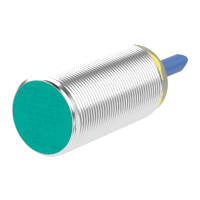
NAMUR érzékelő
A NAMUR kimeneti kapcsolók feszültség- és áramjellemzői olyan alacsonyak, hogy robbanásveszélyes környezetben is biztonságosan használhatók. Az azonosító után „N” betűvel ellátott, néha számmal kombinált termékmodellszámok jelölik ezt a termékcsaládot.
A teljesítménykorlátozásról az adott berendezés gondoskodik. Ez azt jelenti, hogy a NAMUR közelítésérzékelőt tartalmazó áramkör csak akkor gyújtószikramentes, ha egy megfelelő izolált erősítőn keresztül kapja a tápellátást.
Proximity switches for valve actuators
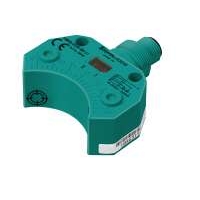
Valve position feedback sensor
Product flow instruments are used in many of the process Industries. In the majority of applications these instruments are controlled using a shaft rotation of 90° with the valve position status used as feedback to the control system.
Our valve position feedback sensors are available in both standard housings according to VDI/VDE 3845 as well as in open solutions.
These proximity sensors are offered in styles for direct mounting onto the actuator for fast connection, easy replacement and extreme compactness. Also, in standardized housing shapes that are well protected and provide integrated terminals for the switch and control valve.
Ring proximity switches
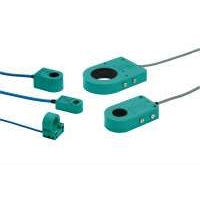
Ring proximity switches
Ring style proximity switches are fitted with a coil so that the switch is activated as soon as a metallic object is found inside the circumference of the ring.
Typical applications include the detection and counting of small metal parts, which are passed through the ring proximity sensor. Both ferrous (FE) and nonferrous (NFE) metals will be detected.
Slotted proximity sensors
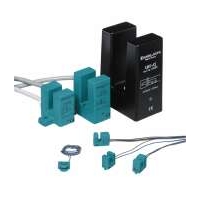
Slotted proximity sensors
Slotted proximity sensors consist of a two coil system sensing across the slot opening. If a piece of metal is inserted into the slot sensor, the inductive coupling between coils will be reduced based on the depth of the target metal. Once this coupling falls below its critical value the proximity switch will be activated.
Due to the nature of the sensor design, this type of proximity switch is less affected by metal characteristics as well as being less sensitive to target position changes in the direction of the core axis.
Proximity switches with protection category IP69k
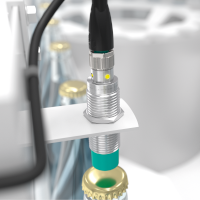
IP69k proximity switch
Under certain environmental conditions the reliability of standard sensors cannot be guaranteed for long operational life. For example, if a standard proximity sensor is exposed to high-pressure water jets in a car wash system, water can forced into the sensor and create a potential cause for failure. For this reason Pepperl+Fuchs designed in new sensor features to reduce the effects of high pressure environments and ensure problem-free use in such applications.
Design features of our proximity switches include a tighter construction fit of mechanical parts such as plastic caps and sensor housing, plasma cleaning of all surfaces to which sealant is applied and the pre-sealing of the coil system. This allows for characteristics to be achieved which are significantly above the test requirements for IP67/ IP68 ratings.
Proximity sensors for use in strong DC and AC fields (weld-proof)
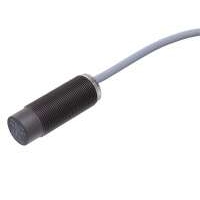
Weld field immune proximity sensor
Proximity sensors used in welding systems are characterized by their high resistance to strong magnetic fields and an increased mechanical robustness suitable for the rough ambient conditions. This family of sensors has a sensing face made of durable Ryton to protect against molten metal plus a weld resistant coated brass housing.
Proximity switches with safety function
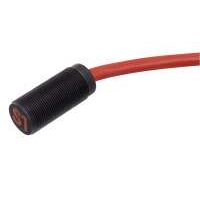
Proximity switch with safety function
These proximity switches correspond to the NAMUR product type but offer the following specific behavior: In case of malfunction of the sensor, the control interface unit or the common power line the output of the control interface unit will automatically switch into the safe "off" condition.
These sensors are identified by SN or S1N after the identification. The safety function can only be guaranteed in conjunction with appropriate control interface units.










 +36 88 545 902
+36 88 545 902